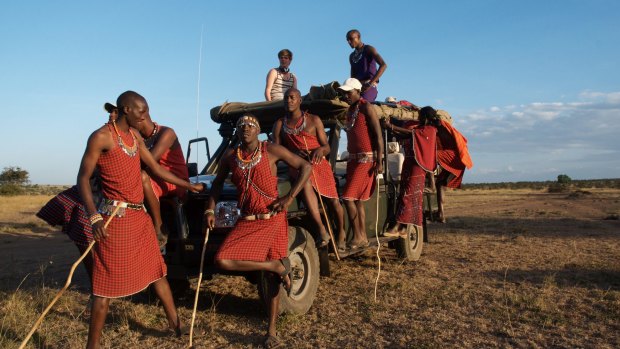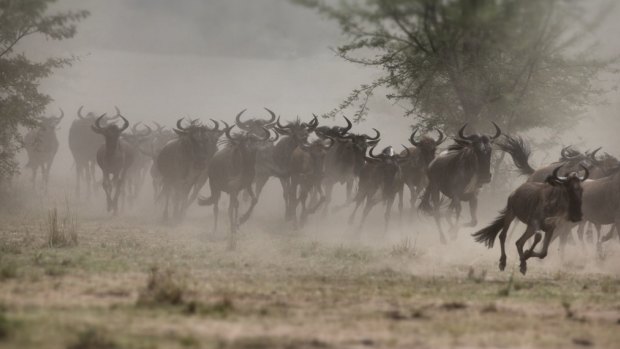This was published 5 years ago
Serengeti, Africa: The sight that never fails to leave travellers awestruck
By Sue Williams

Alex Walker's Serian guides help visitors enjoy spectacular sights across the Serengeti.
It's a wondrous sight that strikes awe into anyone who sees it.
Spanning out on the lush green plains in every direction are thousands upon thousands of wildebeest, nearly every single animal with a tiny calf glued to its side, running this way, then that, before breaking the line, pausing to regroup and then running some more.

The wildebeest's massive annual migration to follow the rains in Tanzania is branded one of the great natural seven wonders of the world.
What are they running from? Where are they running to? Do they even know?
Legendary Serengeti guide Alex Walker puts down his binoculars and smiles. "Sure they run, and I think you'd run too if you were the favourite dish on everybody's menu around here," he says. "Lion, leopard, hyena, wild dogs, baboon, cheetah – and this is the best place in the world to see cheetah … The wildebeest keep every predator going.
"Within five minutes of being born the wildebeest calves are standing up and learning to run. After 15 minutes they can run as fast as their mothers. Running is hardwired into their genes. And there are so many animals to run from …"
We're out on the vast southern Serengeti grasslands of Tanzania, East Africa's fabled birthing grounds for a population of wildebeest estimated to number up to 2 million. It's to here that they make the long trek from the north each year to settle from December to May to have their 200,000 to 250,000 babies during the rainy season of green pastures and plenty.
It's simply beautiful to chance on a dark grey and black wildebeest dropping a golden-coated calf, and to watch the youngster struggle to its feet, try to balance on its long angular legs, tie itself in knots, fall over, and then be gently nudged by its mother to try again. The calf then staggers back up, leaning on its mother for support, takes a few steps, trips, collapses … and starts all over again.
But it's true: within 10 minutes, the calf is bounding around, leaping with joy at its newfound freedom and then starting to trot, canter and finally run, but always warily close to the side of its mother.
With good reason, too. The prospect of a feed of tender young wildebeest attracts a multitude of predators at this time of year, too.
Lion lie lazily on rocky escarpments overlooking the plains teeming with wildebeest rushing past below, appearing for all the world like they're choosing their dish from a sushi train. Leopards loll in trees watching, and cheetah sit on the ridge, biding their time picking out their next tasty target.
Meanwhile, perched on the sharp-thorned branches of every acacia tree are half-a-dozen vultures hanging out, waiting for something to happen, as if they're taking bets on who's going to be next to fall prey.
It's never a foregone conclusion, though. As one hyena hungrily approaches a calf, five wildebeest race over to its mother to form a protective circle, and send it packing, tail between its legs. Most predators, however, are luckier, and about 1000 calves are lost a day on this extraordinary canvas of birth, life and death.
This drama on such a massive scale is what has drawn Alex Walker to this area for the last 33 years, and led him to setting up his own Serian tented camp nine years ago in the short grassed south-western section. Right in the middle of the action, this big bear of a man with a mass of wild curls has six luxury tents – complete with their own bathrooms, king-sized beds draped in mosquito netting, and lounge areas with chairs and tables – with a stunning candle chandelier-lit communal dining and lounge tent nearby.
There, visitors swap stories of the day's sightings from early morning, afternoon, evening and night game drives and game walks with local tribal warriors armed with bows and arrows. The day we walked, our Hadzabe guides ended up in an impromptu archery competition with rival Maasai warriors. Every evening, everyone dines together on unexpectedly sophisticated food: think cheese souffle for starters, beef and vegetable medley, and panna cotta for dessert. Then they sleep to the sonorous grunting of the wildebeest pacing all around.
Finally, every May, Walker, 50, packs up the whole outfit and moves it all to the north of the Serengeti so guests can follow the wildebeest's massive annual migration to follow the rains, branded one of the great natural seven wonders of the world. Here they can see the river crossings, with thousands of wildebeest thundering over the water, many taken by crocodiles and other predators on the way.
"It becomes strangely quiet down here when they all start heading north," says Tanzania-born Walker, who spent his childhood with the trackers for his big game hunter father, also from Tanzania. "It's like when you have family visiting and they all leave and the house feels empty, but at the same time, you do enjoy the quiet.
"That's when we head north too, to set up camp further north to watch the drama of the river crossings and to explore that area, get into step with the wilderness and see what nature reveals to you there when you become part of the scenery."
Walker is an expert at doing exactly that. Twice voted Best Guide in Africa in the Good Safari Guide Awards, in 2014 and 2015, the bush is his home, and his knowledge about the animals and birds is encyclopaedic. He's also an authority on the local flora, recounting research on how the acacia trees the elephants eat send out underground electronic signals to warn others when they're under attack, and secrete a tannin to make their leaves taste more bitter. He also rigorously trains all his guides to his own high standards.
"It sounds a cliche but Alex is really at one with nature," says one of his guides, Australian zoologist Clint Schipper, 44, who has worked in Tanzania, Kenya and Uganda for 17 years, the last five with Walker. "He's one of those guys who blends in seamlessly with what's going on around him, and he tries to give that same experience to his guests.
"He really offers a unique wildlife experience and that's what Serian is all about – all the comfort you need in a camp, but surrounded by wilderness and wildlife."
As well as the mobile camps in the south and north, Walker also operates two other mobile camps in the Tanzanian Serengeti, as well as three more camps and a treehouse in Kenya's Maasai Mara, over the border.
In his evenings off, he likes nothing more than digging a hole, lining it with a ground sheet, then warming a bucket of water over a fire so he can soak under the stars with a glass of good wine. "There's something about the freedom of all this space," he says, looking around as the male wildebeest buck, jump, scuff up the dust, run and brawl with each other, while the females guard their cavorting young.
"It's just so fabulous. And look at all these wildebeest everywhere … How can you possibly describe such an incredible sight to someone who's never seen it?"
TRIP NOTES
MORE
The Classic Safari Company, Ph (02) 9327 0666; See classicsafaricompany.com.au.
FLY
Qatar Airways flies to Dar es Salaam via Doha, and Emirates flies via Dubai, then there's an internal Coastal Aviation flight to Mwiba Southern Serengeti. See qatarairways.com, emirates.com, coastal.co.tz.
STAY
Alex Walker's Serian camp in southern Serengeti has six luxury tents, with a communal dining and lounge tent. There are warm bucket showers, electricity powered by solar and generators, and plenty of fresh water for drinking supplied. Open December to May when the same camp is transported to the north of the Serengeti. He also has other camps in Tanzania and Kenya. Serian.com.
Book via The Classic Safari Company: Ph (02) 9327 0666; See classicsafaricompany.com.au
Sue Williams travelled courtesy of The Classic Safari Company
THE WILDEBEEST MIGRATION
Often branded the World Cup of Wildlife, the wildebeest migration through East Africa is considered one of the most stirring sights of the natural world.
Wildebeest – or gnus as they're sometimes also known – have been travelling for millions of years in a never-ending circle, from the birthing grounds of the southern Serengeti in Tanzania, to the north-west, over the mighty Mara River to the north, then back down again every December. They follow the rains and the grasses that spring up after the wet.
Inside the mass of wildebeest are miles of single files of animals, in long, unbroken lines. They're often joined by zebra, who know they're safer in their company as predators usually prefer to eat wildebeest, and by giraffe who can act as lookouts for danger.
Sign up for the Traveller Deals newsletter
Get exclusive travel deals delivered straight to your inbox. Sign up now.